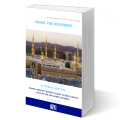The Arabic language is known for its rich history, beautiful script, and global significance. One essential aspect of learning Arabic is mastering the numeric system, which is not only useful for daily life but also a crucial part of understanding the culture and language. In this guide, we will explore the numbers in Arabic, from their basic forms to more complex usages, while offering tips to help you master them efficiently.
Don’t want to go through the translation anymore?
30 free minutes with your qualified Egyptian teacher.
Interestingly, the numbers we use in many parts of the world today (0-9) are known as “Arabic numerals.” This is because they were developed by mathematicians in the Islamic world and later adopted by Europe through translations of Arabic scientific texts. However, the Arabic-speaking world uses a different set of symbols to represent numbers, known as “Eastern Arabic numerals.” Despite this difference in appearance, the basic concepts and mathematical principles remain the same.
The foundation of the Arabic numbering system begins with learning how to count from 0 to 10. Here is a breakdown of these numbers with their corresponding Arabic numerals:
| Number | Arabic Script | Transliteration |
|---|---|---|
| 0 | ٠ | sifr |
| 1 | ١ | wahid |
| 2 | ٢ | ithnan |
| 3 | ٣ | thalatha |
| 4 | ٤ | arba’a |
| 5 | ٥ | khamsa |
| 6 | ٦ | sitta |
| 7 | ٧ | sab’a |
| 8 | ٨ | thamaniya |
| 9 | ٩ | tis’a |
| 10 | ١٠ | ashara |
The numbers in Arabic follow a consistent pattern, which makes learning them easier as you progress to higher numbers. Start by mastering the numbers from 1 to 10, as these form the basis for all subsequent numbers.
Once you’ve learned the numbers from 0 to 10, the next step is to extend your knowledge to larger numbers. The pattern for counting beyond 10 in Arabic involves a combination of single digits and tens, just like in English.
For example, 11 (١١) in Arabic is “ahada ‘ashar,” and 20 (٢٠) is “‘ishrun.” Here’s a quick look at numbers 11 through 20:
| Number | Arabic Script | Transliteration |
|---|---|---|
| 11 | ١١ | ahada ‘ashar |
| 12 | ١٢ | ithna ‘ashar |
| 13 | ١٣ | thalatha ‘ashar |
| 14 | ١٤ | arba’a ‘ashar |
| 15 | ١٥ | khamsa ‘ashar |
| 16 | ١٦ | sitta ‘ashar |
| 17 | ١٧ | sab’a ‘ashar |
| 18 | ١٨ | thamaniya ‘ashar |
| 19 | ١٩ | tis’a ‘ashar |
| 20 | ٢٠ | ‘ishrun |
Numbers beyond 20 follow a similar structure, with the tens being added before the single digits. For instance, 21 is “wahid wa ‘ishrun,” meaning “one and twenty,” and this pattern continues all the way to 99.
Once you’ve mastered numbers up to 100, expanding into hundreds and thousands becomes straightforward. Here’s how the pattern works:
Hundreds: The word for 100 is “mi’a” (١٠٠). Numbers such as 200, 300, etc., follow the structure “mi’atayn” for 200, “thalath mi’a” for 300, and so on.
Thousands: The Arabic word for 1,000 is “alf” (١٠٠٠). Like hundreds, numbers such as 2,000, 3,000, etc., are formed with “alfayn” for 2,000 and “thalathat alaf” for 3,000.
An important rule to remember when using numbers in Arabic is that numbers can change depending on the gender of the noun they modify. Arabic nouns are either masculine or feminine, and the numbers 3 through 10 have gender-specific forms.
For example:
This is a unique feature of Arabic that may take some getting used to, but with practice, it becomes second nature.
Ordinal numbers (first, second, third, etc.) in Arabic follow a different pattern from cardinal numbers (one, two, three). Here are the Arabic ordinal numbers from first to fifth:
| Ordinal Number | Arabic Script | Transliteration |
|---|---|---|
| 1st | الأوَّل | al-awwal |
| 2nd | الثَّاني | al-thani |
| 3rd | الثَّالِث | al-thalith |
| 4th | الرَّابِع | al-rabi’ |
| 5th | الخَامِس | al-khamis |
Ordinal numbers are useful for many practical situations, such as giving directions or specifying dates.
Understanding numbers in Arabic is a fundamental skill for anyone learning the language. Whether you’re traveling in an Arabic-speaking country, engaging in business, or simply expanding your language abilities, mastering the Arabic numeric system opens up a new world of communication. From the basic numbers to more complex forms, with consistent practice, you can quickly build your fluency and confidence.
To know more: Discover our Online Courses to Learn Arabic Langage
Discover the experiences of our delighted clients who have thoroughly enjoyed utilizing this standout feature.
Alhamdulillah I‘m very pleased with the arabic and Qur’an lessons I receive from teacher Umm Tasneem and I‘m also content with the al-dirassa administration team who were very quick in answering any questions I had. In a month I progressed a lot and I cannot wait to continue my studies with al-dirassa. May Allah reward everyone at al-dirassa.
![]() Verified review - view original
Verified review - view original
My Qur’an teacher is fantastic, she teaches me in a loving and kind way where I look forward to the lessons and learn so much. My Arabic teacher is equally as nice and has a lot of patience with me, she has great expertise in the field and I’ve progressed really quickly with her. Thank you Al-dirassa!
![]() Verified review - view original
Verified review - view original

Al-dirassa Institute offers you a gift to help you begin your journey to being fluent in Arabic and learning the Quran.

Al-dirassa Institute offers you a gift to help you begin your journey to being fluent in Arabic and learning the Quran.